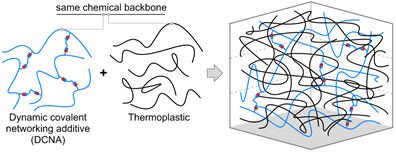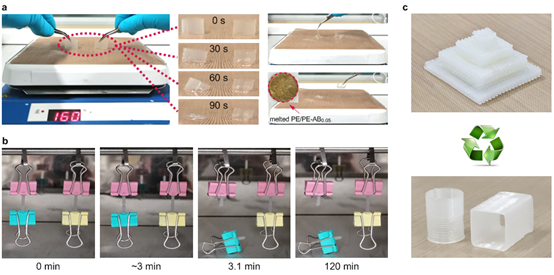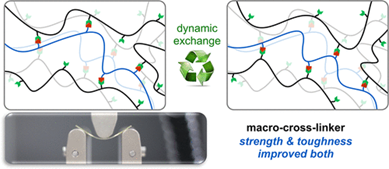 +565 975 658
+565 975 658
 info@premiumcoding.com
info@premiumcoding.com
 Monday - Friday, 8.00 - 20.00
Monday - Friday, 8.00 - 20.00
Chen's Group Has Made Important Progress in Dynamic Crosslinked Polyethylene
Polyethylene (PE), with over 100 million tons produced each year, is the most widely used polymer in the world. As a typical thermoplastic material, PE is light, durable and easy to process but is limited by the decreased strength, creep resistance and stability when heated. Among various PEs, low-density PE (LDPE) is flexible and thermally vulnerable. Cross-linking with covalent bonds has been used to improve properties (e.g., mechanical and rheological performance) of PE under thermal conditions. However, the synthesis and processing of cross-linked PE (CLPE) require dramatically increased input of energy and cost. Moreover, the permanently cross-linked network brings energetic barriers to bond cleavage in the realization of polymer recycling. It is valuable to improve the thermal resistance of LDPE without losing its reprocessability.
To address this challenge, Chen's group have developed a dynamic covalent networking additive (DCNA) strategy to endow thermoplastic PE with CAN characteristics while avoiding influence on intrinsic properties of PE resulted from chemical modification or polarity change. Specifically, through physically introducing a small amount of DCNA with a similar backbone as PE, the internal nature of PE can be simply converted to resemble a CAN regime due to the synergistic effects of different chain entanglements on the morphological behaviors. Additionally, compared with lots of CANs requiring functional monomers or crosslinkers with dynamic linkages as major building blocks, this additive strategy represents an amenable alternative to improve PE commodities.

Figure 1 Illustration of the dynamic covalent networking additive (DCNA) strategy
Based on the dynamic alkylboron chemistry, they have demonstrated the DCNA strategy to transform thermoplastic PE into CAN materials, enabling high-temperature mechanical durability without disturbance of performance for native PE. With merely 5 wt% of additive incorporation, the tensile strength, Young’s modulus and creep resistance are increased.

Figure 2 Creep resistance and tensile tests of the PE materials
The heat-resistant performance of PE/PE-AB0.05 and PE was compared by placing two materials on a hot plate at 160 ˚C. In sharp contrast, although the cylinder made of PE/PE-AB0.05 underwent deformation, the incorporation of DCNA precluded adhesion on the hot plate and fluidization. When two materials were hung in an oven at 160 ˚C, PE sample was melted and broken while PE/PE-AB0.05 could maintain its original shape without apparent deformation.

Figure 3 Heat resistance of the PE materials and the 3D printing of PE/PE-AB0.05
Finally, they investigated the 3D printability of PE/PE-AB0.05. The material was firstly printed into a pyramid and then reprinted into hollow cylinder and square column, highlighting that the combined polymer based on PE thermoplastic and DCNA possesses outstanding re-processability and compatibility for 3D printing. This DCNA strategy can be generally adapted to different polymer structures, providing a simple, convenient and practical platform to integrate CAN merits into commercial thermoplastics, facilitating direct upgrading and diversification of existing materials to expand their potential application scope.
Before this, they also had been reported a macro-crosslinking strategy based on reversible boronic ester bond. In that work, reconfigurable and catalyst-free thermosets were synthesized by dynamic polymer–polymer interaction, providing readily and efficient access toward materials with improved mechanical strength and toughness in comparison to related commodity thermoplastics. (see Macromolecules 2020, 53, 3, 956–964).

图4 大分子交联策略合成动态交联聚合物
The above results were published in Macromolecules. The first author of the work is Zongtao Wang and corresponding author is Prof. Mao Chen. This research was financially supported by National Natural Science Foundation of China (no. 21971044). And the research work also strongly supported by State Key Laboratory of Molecular Engineering of Polymers.
Get to know us better now!

Wechat:FDUMMers
Search!
Search across our website
Revenant @ 2018 by fudan | All Rights Reserved
Powered by Weicheng

